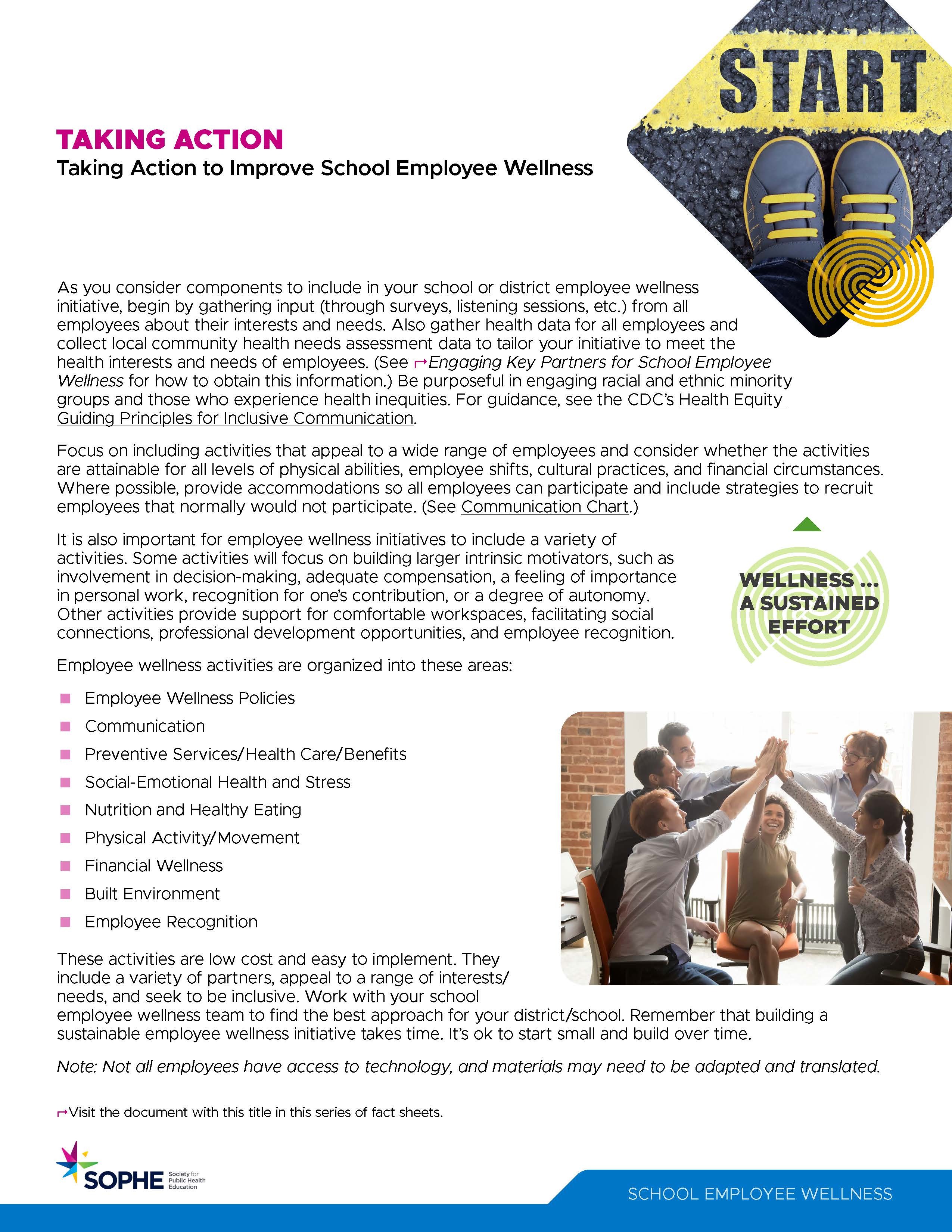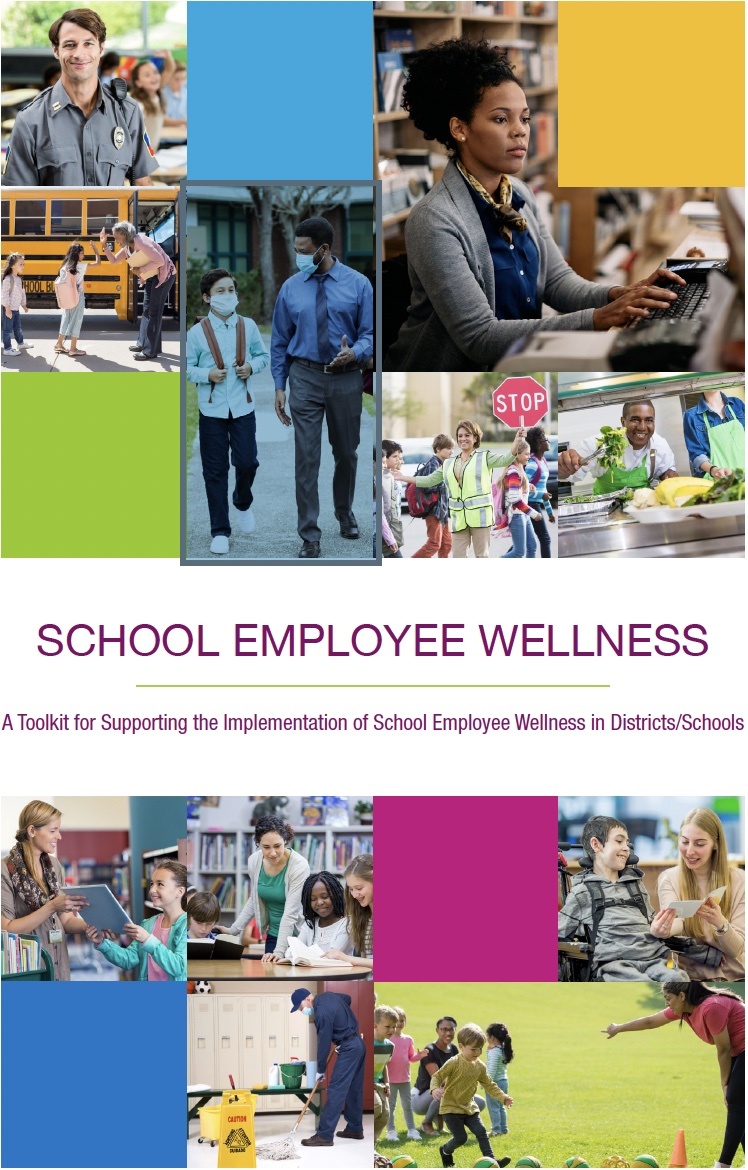
Taking Action to Improve School Employee Wellness

This fact sheet provides a variety of low-cost, easy-to-implement activities for employee wellness that include a variety of partners, appeal to a range of interests/needs, and seek to be inclusive. Activities are divided into these areas:
- Employee Wellness Policies
- Communication
- Preventive
- Services/Health Care/Benefits
- Emotional Well-Being and Stress
- Nutrition and Healthy Eating
- Physical Activity/Movement
- Financial Wellness
- Built Environment
- Employee Recognition
- Other
To download fact sheet, please click Taking Action to Improve School Employee Wellness.

As you consider components to include in your school or district employee wellness initiative, begin by gathering input (through surveys, listening sessions, etc.) from all employees about their interests and needs. Also gather health data for all employees and collect local community health needs assessment data to tailor your initiative to meet the health interests and needs of employees. (See Engaging Key Partners for School Employee Wellness for how to obtain this information.) Be purposeful in engaging racial and ethnic minority groups and those who experience health inequities. For guidance, see the CDC’s Health Equity Guiding Principles for Inclusive Communication.
Focus on including activities that appeal to a wide range of employees and consider whether the activities are attainable for all levels of physical abilities, employee shifts, cultural practices, and financial circumstances. Where possible, provide accommodations so all employees can participate and include strategies to recruit employees that normally would not participate. (See Communication Chart.)
It is also important for employee wellness initiatives to include a variety of activities. Some activities will focus on building larger intrinsic motivators, such as involvement in decision-making, adequate compensation, a feeling of importance in personal work, recognition for one’s contribution, or a degree of autonomy. Other activities provide support for comfortable workspaces, facilitating socialconnections, professional development opportunities, and employee recognition.
References
1Doris A. Santoro and Olga Acosta Price, Structural Supports to Promote Teacher Well-Being (Providence, RI: EdResearch for Recovery, October 2021), https://annenberg.brown.edu/sites/default/files/EdResearch_for_Recovery_Brief_19.pdf
2“Make Wellness a Priority,” Alliance for a Healthier Generation, accessed December 13, 2022, https://www.healthiergeneration.org/
3Janet Weiner, “Cost Effectiveness of Financial Incentives for Smoking Cessation,” Population Health (blog), PENN Leonard Davis Institute of Health Economics, December 9, 2021, https://ldi.upenn.edu/our-work/research-updates/cost-effectiveness-of-financial-incentives-for-smoking-cessation/
4OEA Choice Trust, Blueprint for Education Employee Well-Being. Retrieved from Oregon Education: Association (Tigard, OR: OEA Choice Trust, February 28, 2022), https://oeachoice.com/wp-content/uploads/2022/02/Blueprint-2-28-22.pdf
5National Association of Chronic Disease Directors, Healthy School, Healthy Staff, Healthy Students: A Guide to Improving School Employee Wellness (Decatur, GA: National Association of Chronic Disease Directors, 2018), https://chronicdisease.org/healthy-school-staff-students-a-guide-to-improving-school-employee-wellness/
6Mark T. Greenberg, Joshua L. Brown, and Rachel Abenavoli, Teacher Stress and Health: Effects on Teachers, Students, and Schools, Edna Bennett Pierce Prevention Research Center, Pennsylvania State University, September 2016, https://prevention.psu.edu/
7J. S. House, K. R. Landis, and D. Umberson, “Social Relationships and Health,” Science 214, no. 4865 (1988):540–545, https://doi.org/10.1126/science.3399889.
8“Make Wellness a Priority,” Alliance for a Healthier Generation.
9Dale Buss, “Teaching Employees the Financial Facts of Life,” SHRM Executive Network, October 4, 2021, www.shrm.org/executive/resources/articles/pages/financial-wellness-helps-business.aspx.
10National Association of Chronic Disease Directors, Healthy School, Healthy Staff, Healthy Students.
11Dianna Podmoroff, 365 Ways to Motivate and Reward Your Employees Every Day: With Little or No Money (Ocala, FL: Atlantic Publishing Group, January 12, 2005).
12Gary M. Hopkins, “Recognizing the Stars on Your Staff,” Education World, December 2019, https://www.educationworld.com/a_admin/admin/admin538.shtml
| Access Date | Quiz Result | Score | Actions |
|---|

